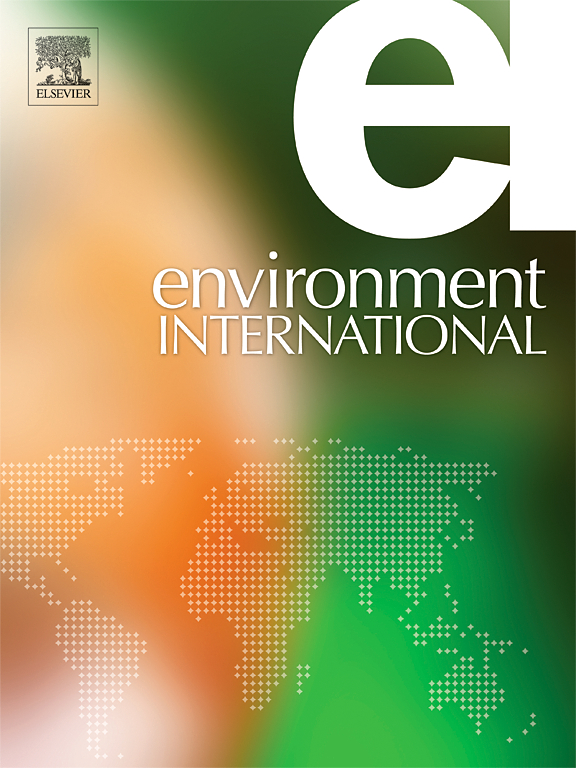支链全氟己烷磺酸(PFHxS)和全氟庚酸(PFHpA):"更安全 "的全氟烷基和多氟烷基物质(PFAS)替代品对儿童肠道微生物群和代谢功能的影响
IF 9.7
1区 环境科学与生态学
Q1 ENVIRONMENTAL SCIENCES
引用次数: 0
摘要
本研究考察了支化全氟己磺酸(PFHxS)和全氟庚酸(PFHpA)这两种全氟烷基物质和多氟烷基物质(PFASs)的替代品对中国6 ~ 9岁 儿童肠道微生物群和代谢功能的影响。共招募了336名儿童,提供了血浆和粪便样本。通过16S rRNA基因测序评估肠道菌群组成,利用靶向代谢组学分析和高效液相色谱分析粪便代谢物和短链脂肪酸(SCFAs)。采用超高效液相色谱-串联质谱法(UPLC-MS/MS)检测血浆样品中的PFASs。结果显示,暴露于PFHpA显著降低了肠道微生物群的微生物多样性和丰富度。发现特定菌属与支化PFHxS和PFHpA暴露呈正相关或负相关(β = -0.008—0.009,P_fdr = <0.001—0.048),其中Parabacteroides组与支化PFHxS呈正相关,Lachnospiraceae组与PFHpA负相关。代谢组学分析显示,PFHxS和PFHpA暴露与粪便代谢物谱的明显变化相关(β = -0.182—0.177,P_fdr = 0.015—0.172),特别是脂肪酸和氨基酸的减少。此外,较高的PFHpA暴露与SCFA谱(如戊酸)的减少有关(β = -0.691−-0.341,P = 0.011—0.030)。该研究为PFASs替代品,特别是分支PFHxS和PFHpA对儿童肠道微生物群和代谢健康的潜在不良影响提供了新的见解。本文章由计算机程序翻译,如有差异,请以英文原文为准。


Branched perfluorohexanesulfonic acid (PFHxS) and perfluoroheptanoic acid (PFHpA): ’Safer’ per- and polyfluoroalkyl substances (PFASs) alternatives for their effects on gut microbiota and metabolic function in children
This study examined the effects of branched perfluorohexanesulfonic acid (PFHxS) and perfluoroheptanoic acid (PFHpA), two alternatives to per- and polyfluoroalkyl substances (PFASs), on gut microbiota and metabolic function in Chinese children aged 6–9 years. A total of 336 children were enrolled, providing plasma and fecal samples. Gut microbiota composition was assessed through 16S rRNA gene sequencing, and fecal metabolites and short-chain fatty acids (SCFAs) were analyzed using targeted metabolomics profiling and high-performance liquid chromatography (HPLC), respectively. PFASs in plasma samples were detected using ultra-performance liquid chromatography–tandem mass spectrometry (UPLC-MS/MS). The results revealed that exposure to PFHpA significantly reduced microbial diversity and richness in the gut microbiota. Specific bacterial genera were found to be positively or negatively associated with branched PFHxS and PFHpA exposures (β = –0.008–––0.009, P_fdr = <0.001–––0.048), with Parabacteroides positively correlated with branched PFHxS and Lachnospiraceae FCS020 group negatively correlated with PFHpA. Metabolomic analysis showed that branched PFHxS and PFHpA exposures were associated with distinct changes in fecal metabolite profiles (β = –0.182–––0.177, P_fdr = 0.015–––0.172), particularly reducing fatty acids and amino acids. Additionally, higher exposure to PFHpA was linked to a reduction in SCFA profiles, such as valeric acid (β = –0.691 − –0.341, P = 0.011–––0.030). This study offers new insights into the potential adverse effects of PFASs alternatives, specifically branched PFHxS and PFHpA, on the gut microbiome and metabolic health in children.
求助全文
通过发布文献求助,成功后即可免费获取论文全文。
去求助
来源期刊

Environment International
环境科学-环境科学
CiteScore
21.90
自引率
3.40%
发文量
734
审稿时长
2.8 months
期刊介绍:
Environmental Health publishes manuscripts focusing on critical aspects of environmental and occupational medicine, including studies in toxicology and epidemiology, to illuminate the human health implications of exposure to environmental hazards. The journal adopts an open-access model and practices open peer review.
It caters to scientists and practitioners across all environmental science domains, directly or indirectly impacting human health and well-being. With a commitment to enhancing the prevention of environmentally-related health risks, Environmental Health serves as a public health journal for the community and scientists engaged in matters of public health significance concerning the environment.
 求助内容:
求助内容: 应助结果提醒方式:
应助结果提醒方式:


